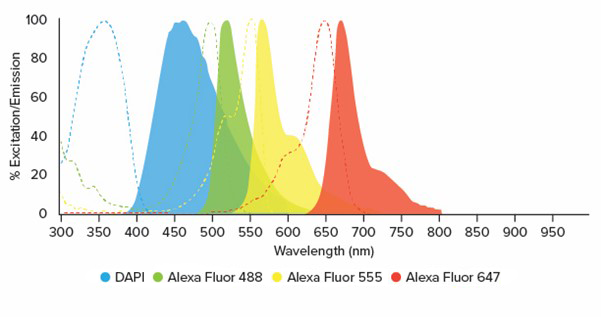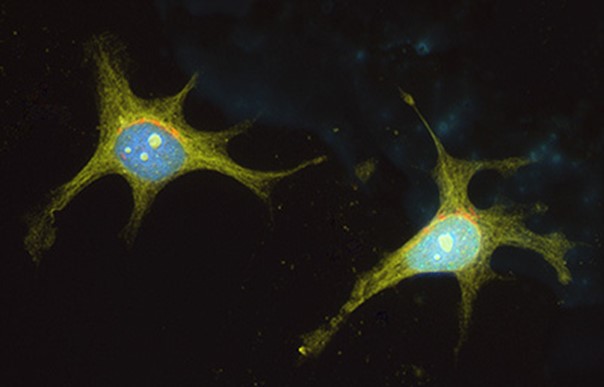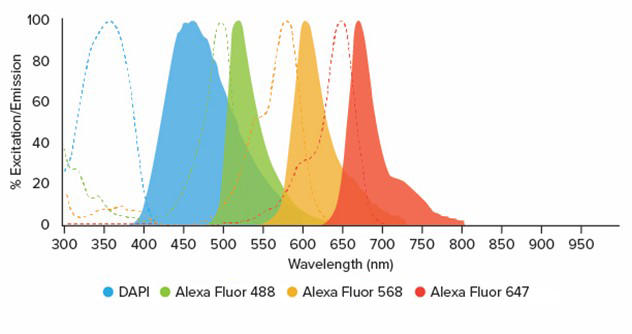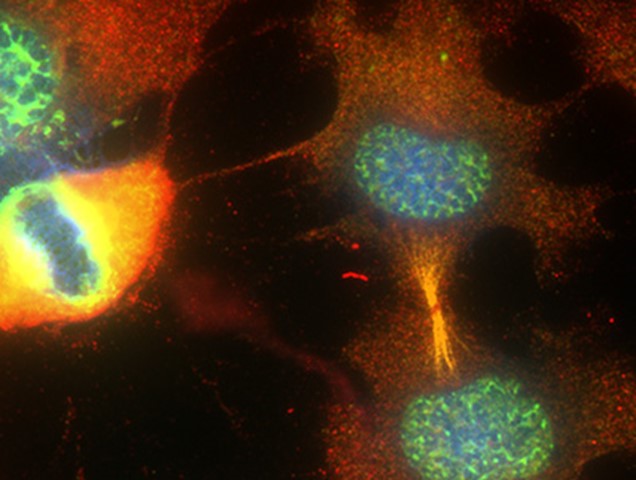
"I have used a wide variety of secondaries and Jackson ImmunoResearch has consistently been the best. The fluorophores are bright and stable and their selective (x reactivity removed) secondaries have always shown species specificity in multiple labeling."
Janet Duerr, Ohio UniversityRating: 5.0
Jackson ImmunoResearch now offers Alexa Fluor® 555 and 568 secondary antibody conjugates. With two new choices for the orange channel, panel design is even easier. Here, we demonstrate the utility of JIR Alexa Fluor® conjugates in two examples of four-color immunofluorescence staining protocols.
When developing an immunofluorescence experiment with multiple targets, a range of spectrally distinct fluorescent dyes and secondary antibodies that are cross-adsorbed against other species in the assay are essential for the specific detection of each target with unambiguous results.
Bright and easy to use, Alexa Fluor® dye-conjugated secondary antibodies from Jackson ImmunoResearch are now available as two new conjugates, Alexa Fluor® 555 and 568. These two new dyes complement our existing range of Alexa Fluor® conjugated secondary antibodies, offering two new choices for the orange channel.
Alongside a spectrum-wide range of fluors, Jackson ImmunoReseach Alexa Fluor® conjugated secondary antibodies are available in a broad range of target specificities. They are conjugated to Donkey or Goat host secondary antibodies that are minimally cross-reactive to many common species to avoid cross-talk between multiple primary antibodies.
Here, we demonstrate how to combine Alexa Fluor® 555 or 568 into your four-color immunofluorescence experiments.
The spectral characteristics of the three Alexa Fluor® dyes in this panel (Figure 1) allow for their combination with DAPI nuclear stain for effective four-color immunofluorescence. We demonstrated this fluorophore combination by staining Human epithelial (HEp-2) cells for common intracellular protein markers. Ki-67 protein, a marker of cellular proliferation (Scholzen and Gerdes., 2000), can be seen in green. Aspects of the cytoskeleton structure can be seen in yellow and were visualized by staining microtubules using Anti-α tubulin. Cis-Golgi matrix protein, involved in the stacking of Golgi cisternae and maintenance of Golgi structure (Chang et al., 2012), was visualized using Anti Human GM130/GOLGA2 and can be seen in red at the edge of the nucleus. The nucleus was stained with DAPI and can be seen in blue. (Figure 2).
| Alexa Fluor® | Excitation Peak (nm) | Emission Peak (nm) | |
|---|---|---|---|
| DAPI | 350 | 465 | |
| Alexa Fluor® 488 | 493 | 519 | |
| NEW! | Alexa Fluor® 555 | 552 | 572 |
| Alexa Fluor® 647 | 651 | 667 |


Sample: Human epithelial (HEp-2) cells , BioRad.
DAPI Mol Probes.
ProLong Gold antifade reagent, Invitrogen.
Another useful combination of dyes that can be used with DAPI for four-color immunofluorescence is Alexa Fluor® 488, 568 and 647 (Figure 3). Figure 4 demonstrates this color combination in Human epithelial (HEp-2) cells stained for common intracellular protein markers.
Ki-67 protein, a marker of cellular proliferation (Scholzen and Gerdes., 2000), can be seen in green. Aspects of the cytoskeleton structure can be seen in yellow and were visualized by staining microtubules using Anti-α tubulin. Cell-to-cell contact was visualized by staining for the epithelial cell marker, E-Cadherin protein, which can be seen in red as filaments alongside the yellow microtubules. The nucleus was stained with DAPI and can be seen in blue.
| Alexa Fluor® | Excitation Peak (nm) | Emission Peak (nm) | |
|---|---|---|---|
| DAPI | 350 | 465 | |
| Alexa Fluor® 488 | 493 | 519 | |
| NEW! | Alexa Fluor® 568 | 577 | 602 |
| Alexa Fluor® 647 | 651 | 667 |


Sample: Human epithelial (HEp-2) cells, BioRad.
DAPI Mol Probes.
ProLong Gold antifade reagent, Invitrogen.